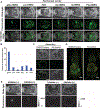Rapid cancer detection by topically spraying a γ-glutamyltranspeptidase-activated fluorescent probe
- PMID: 22116934
- PMCID: PMC7451965
- DOI: 10.1126/scitranslmed.3002823
Rapid cancer detection by topically spraying a γ-glutamyltranspeptidase-activated fluorescent probe
Abstract
The ability of the unaided human eye to detect small cancer foci or accurate borders between cancer and normal tissue during surgery or endoscopy is limited. Fluorescent probes are useful for enhancing visualization of small tumors but are typically limited by either high background signal or the requirement for administration hours to days before use. We synthesized a rapidly activatable, cancer-selective fluorescence imaging probe, γ-glutamyl hydroxymethyl rhodamine green (gGlu-HMRG), with intramolecular spirocyclic caging for complete quenching. Activation occurs by rapid one-step cleavage of glutamate with γ-glutamyltranspeptidase (GGT), which is not expressed in normal tissue, but is overexpressed on the cell membrane of various cancer cells, thus leading to complete uncaging and dequenching of the fluorescence probe. In vitro activation of gGlu-HMRG was evident in 11 human ovarian cancer cell lines tested. In vivo in mouse models of disseminated human peritoneal ovarian cancer, activation of gGlu-HMRG occurred within 1 min of topically spraying the tumor, creating high signal contrast between the tumor and the background. The gGlu-HMRG probe is practical for clinical application during surgical or endoscopic procedures because of its rapid and strong activation upon contact with GGT on the surface of cancer cells.
Figures






Comment in
-
Glowing tumors make for better detection and resection.Sci Transl Med. 2011 Nov 23;3(110):110fs10. doi: 10.1126/scitranslmed.3003375. Sci Transl Med. 2011. PMID: 22116932
-
Comment on "Rapid cancer detection by topically spraying a γ-glutamyltranspeptidase-activated fluorescent probe".Sci Transl Med. 2012 Feb 15;4(121):121le1; author reply 121lr1. doi: 10.1126/scitranslmed.3003686. Sci Transl Med. 2012. PMID: 22344683
-
Rapid response activatable molecular probes for intraoperative optical image-guided tumor resection.Hepatology. 2012 Sep;56(3):1170-3. doi: 10.1002/hep.25807. Epub 2012 Jun 26. Hepatology. 2012. PMID: 22736321 No abstract available.
References
-
- Wallace MB, Kiesslich R, Advances in endoscopic imaging of colorectal neoplasia. Gastroenterology 138, 2140–2150 (2010). - PubMed
Publication types
MeSH terms
Substances
Grants and funding
LinkOut - more resources
Full Text Sources
Other Literature Sources
Miscellaneous

